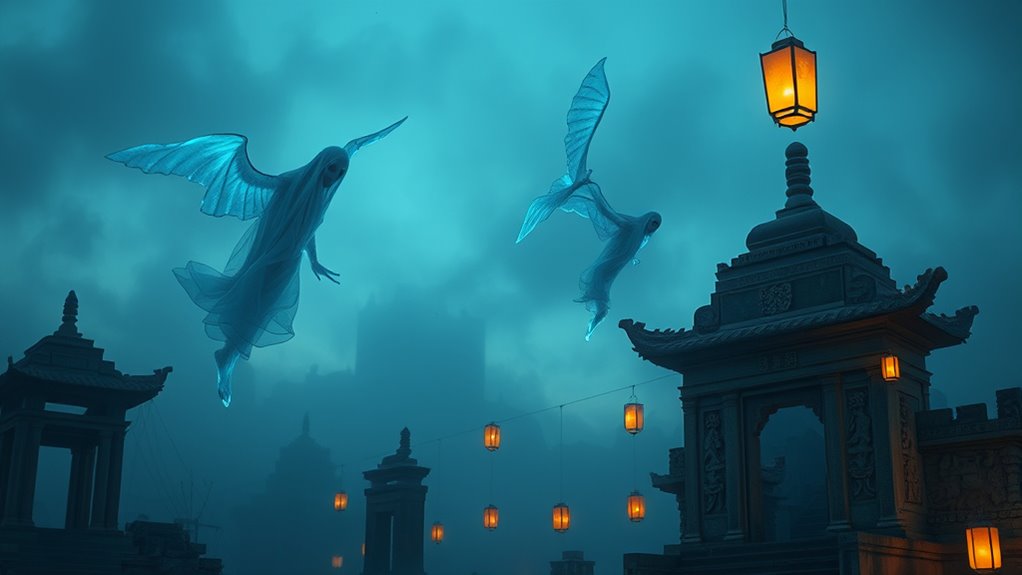Around the world, cultures see spirits and ghosts in unique ways. Western stories often link them to haunted places and unresolved pasts, while Asian traditions honor restless spirits like yūrei through rituals and sacred sites. Indigenous cultures see spirits as guides and protectors that reveal themselves through dreams and ceremonies. Modern investigations use technology to explore these phenomena, blending science with belief. If you explore further, you’ll discover fascinating differences and similarities in how people perceive the unseen.
Key Takeaways
- Cultures worldwide share fascination with spirits, often linking them to unresolved issues, life after death, or ancestral reverence.
- Western traditions associate ghosts with haunted sites linked to tragedy, manifesting as apparitions or unexplained sounds.
- Asian beliefs view spirits like yūrei as restless souls appearing in sacred places, with rituals performed to honor or appease them.
- Modern investigations use technology to explore spiritual phenomena, shaping perceptions of the unseen across cultures.
- Indigenous and African cultures see spirits as protective ancestors manifesting during ceremonies or at sacred locations.

Throughout history, stories of ghosts have fascinated people across cultures and continents. You’ve probably heard tales of spirits wandering through haunted locations, or encountered accounts of spiritual manifestations that defy explanation. These stories aren’t just spooky legends; they reflect deep-seated beliefs about life after death and the idea that some spirits remain tethered to the earthly domain. Different cultures interpret these phenomena uniquely, but universally, they evoke a mix of fear, curiosity, and reverence.
Ghost stories across cultures reveal universal fears, curiosity, and beliefs about spirits lingering after death.
In many Western traditions, haunted locations are often linked to tragic events or unresolved conflicts. You might imagine an old mansion where whispers echo through empty hallways, or a cemetery where shadowy figures appear at dusk. These haunted locations serve as tangible proof of spirits lingering among the living, embodying the idea that the dead haven’t fully moved on. Spiritual manifestations in these settings are frequently described as apparitions, cold spots, or inexplicable sounds, all contributing to the chilling atmosphere that surrounds such places. For some, these phenomena are warnings or messages from beyond, while others see them simply as residual energy left behind by past lives.
Across Asia, spiritual manifestations are deeply woven into religious and cultural practices. In countries like Japan, spirits known as yūrei are believed to be restless souls, often appearing in sacred sites or abandoned temples. These spirits are sometimes vengeful, but more often they are mournful, seeking closure or remembrance. Shrines and temples are considered places where spirits can manifest more readily, and rituals are performed to honor or appease them. In India, the concept of spirits and ghosts is intertwined with beliefs in karma and reincarnation. Haunted locations, such as ancient temples or burial grounds, are seen as portals where the spiritual realm overlaps with the physical world, allowing spiritual manifestations to occur during specific ceremonies or festivals. Additionally, advancements in technological tools like ghost-hunting equipment have influenced how these phenomena are studied and understood. These innovations have led to more scientific investigations, shaping modern perceptions of the unseen.
In Africa, ancestral spirits play a pivotal role in daily life, and the idea of spirits manifesting in the physical world is common. Sacred sites and ritual spaces are believed to be places where spiritual manifestations can happen, often during ceremonies or as messages from ancestors. These spirits are generally viewed as protective, offering guidance or warnings through signs, visions, or physical phenomena. Similarly, in Indigenous cultures across the Americas, spirits are seen as essential parts of the natural world, capable of revealing themselves through signs, dreams, or spiritual encounters at sacred locations.
Interestingly, recent research and anthropological studies have helped to shed light on how these beliefs influence cultural practices and perceptions of the unseen. No matter where you look, these different cultural perspectives highlight a universal fascination with the unseen. Whether as a warning, a message of love, or a reminder of life beyond death, spiritual manifestations and haunted locations continue to stir our imagination and curiosity, bridging the gap between the physical and spiritual worlds.
Frequently Asked Questions
How Do Modern Technologies Influence Ghost Sightings Worldwide?
Modern technologies greatly influence ghost sightings worldwide. Virtual Reality can create immersive experiences that blur the line between real and supernatural, making people more receptive to ghost stories. Social media spreads sightings rapidly, often amplifying them through videos and photos. You might find yourself more likely to believe or encounter ghostly tales as these platforms and technologies shape perceptions, fueling curiosity and skepticism about the unseen forces around us.
Are There Scientifically Proven Methods to Detect Spirits?
Imagine you’re involved in paranormal investigations, trying to find proof of spirits. Currently, there are no scientifically proven methods to detect spirits definitively. Techniques like spirit photography and EMF meters are popular, but they lack conclusive evidence. While some cases, like the famous Brown Lady photo, seem convincing, scientific validation remains elusive. So, if you’re seeking proof, remember that these methods are intriguing but not scientifically confirmed.
How Do Cultural Beliefs Shape Interpretations of Ghost Encounters?
You see, your cultural beliefs and symbolism deeply influence how you interpret ghost encounters. If your belief system views spirits as ancestors or messengers, you’re more likely to see unexplained phenomena as meaningful signs. Different cultures assign specific meanings to ghostly appearances based on their traditions and legends. These interpretations shape your perceptions, making what others see as mere illusions feel significant and real within your cultural context.
What Are the Common Traits of Ghosts Across Different Regions?
You notice that ghosts often share common characteristics across regions. Spectral features typically include translucent or shadowy appearances, with some describing a glowing aura. Many exhibit behaviors like moaning, lingering near specific locations, or appearing during certain times. These common traits reflect universal fears and beliefs, making ghosts a fascinating reflection of human culture. Despite regional differences, their spectral features often evoke similar emotions and mysteries.
How Do Religious Practices Affect Ghost-Related Folklore?
You might notice that religious practices shape ghost folklore through rituals and spiritual symbolism. For example, in Mexico, Día de los Muertos honors spirits with offerings, reinforcing beliefs that ghosts are part of family. Religious rituals can either appease or communicate with spirits, influencing how communities interpret ghostly encounters. These practices help define the cultural meaning of ghosts, blending spiritual beliefs with folklore to create a shared understanding of the unseen.
Conclusion
As you explore the world’s diverse beliefs, you’ll see that ghosts are like threads woven into each culture’s fabric—softly whispering their stories across time. Whether they’re protectors, punishers, or reminders, they remind us that the unseen is always nearby, waiting just beyond the veil. Embracing these beliefs helps you realize that, no matter where you are, the spirits of the past continue to dance around us, silent witnesses to our lives.









